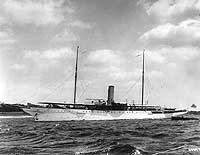 USS Aztec in 1902 | |
| History | |
|---|---|
| Name | Aztec |
| Builder | Crescent Shipyard, Elizabeth, New Jersey |
| Yard number | 99 |
| Launched | 22 April 1902 |
| Fate | Leased by USN 1917, returned 1919, acquired by RCN 1940 |
| Name | Aztec |
| Namesake | Aztec |
| Acquired | 29 June 1917 |
| Commissioned | 30 June 1917 |
| Decommissioned | 15 March 1919 |
| Identification | SP-590 |
| Fate | Returned to owner 7 August 1919 |
| Name | Beaver |
| Acquired | 28 May 1940 |
| Commissioned | 1 April 1941 |
| Decommissioned | 17 October 1944 |
| Identification | Pennant number: S10 (later Z10) |
| Honours and awards | Atlantic 1942 |
| Fate | Sold in 1946 |
| General characteristics | |
| Type | Armed yacht |
| Displacement | 808 long tons (821 t) |
| Length | 260 ft (79 m) |
| Beam | 28 ft (8.5 m) |
| Draught | 13 ft (4.0 m) |
| Speed | 12 knots (22 km/h; 14 mph) |
| Complement | 50 |
| Armament | 1 × 4-inch (102 mm) naval gun |
HMCS Beaver was an armed yacht that served in the Royal Canadian Navy during the Second World War. Originally named Aztec, the yacht was requisitioned for service in the United States Navy during the First World War under the same name. Returned to her owner in 1919, the yacht was laid up in 1931 following her owner's death. The vessel was purchased via a third party for service in the Royal Canadian Navy and after commissioning, Beaver was primarily used as a training ship with limited time as a patrol vessel. Following the war she was sold in 1946 and broken up for scrap in 1956.